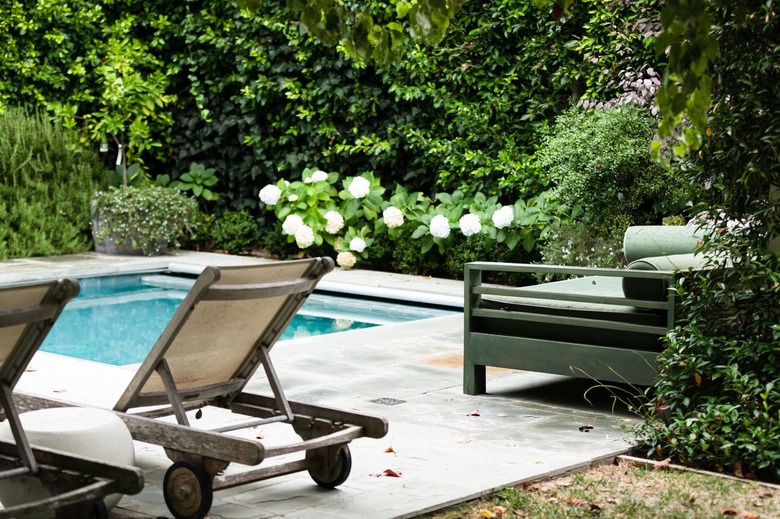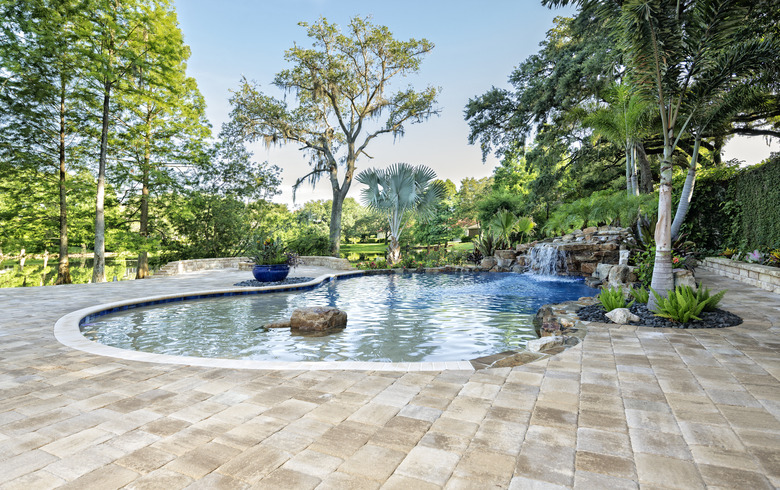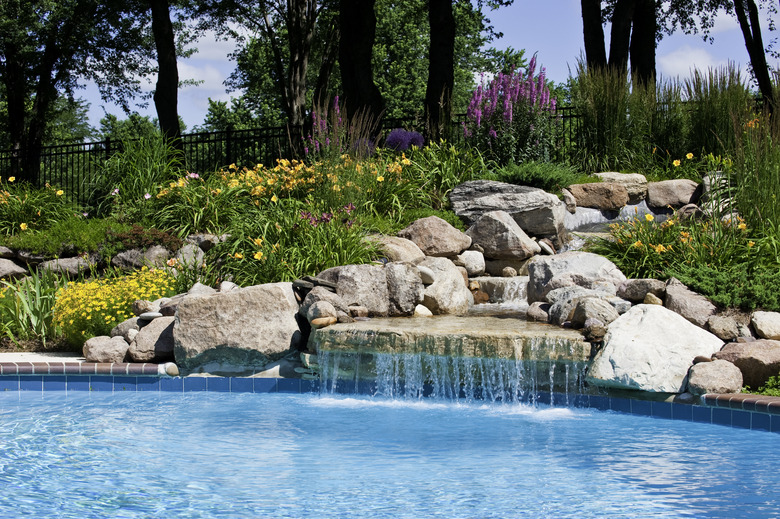How To Choose The Best Plants For Poolside Landscaping
While you may think of your swimming pool as a backyard oasis, the best plants to adorn it aren't necessarily the showy tropical plants you'd find in an oasis. Some qualities trump showiness when it comes to poolside plants, not the least of which is the amount of work they'll create for you. The idea of a large crape myrtle (Lagerstroemia spp., zones 5-10, depending on species and cultivar) shading the pool area with its pretty white, pink, lavender, or red flower clusters may be appealing, but those tiny flowers making up these clusters will have you working overtime to keep the pool's filter system clear.
Another important factor to consider when choosing poolside plants is your growing zone, which determines the plants you can even consider (although you can expand the list of possibilities by growing some in containers so you can bring them indoors for the winter). Other variables to consider when deciding on the best plants for your poolside landscaping include the mature size of trees and shrubs that attract you and the strength of their root systems. You don't want your pool landscaping to include a domineering tree or shrub with aggressive roots that can damage the pool decking or the pool itself.
The area around a backyard pool is typically sunny, so your poolside plants need to be able to tolerate full sun as well as chlorine- or salt-laden water, to which many plants are sensitive. You'll want to choose plants that fit with the existing landscape design, and you may want them to serve a particular purpose, such as providing shade, privacy from the neighbors or lots of color. In short, there's a lot to consider, so begin your search by determining your priorities and then move on to listing the possibilities for your situation.
Tropical Plants for Most Growing Zones
Tropical Plants for Most Growing Zones
The United States Department of Agriculture divides the United States into 13 hardiness zones that range from zone 1 in the northern part of Alaska to zone 13 in Puerto Rico and some parts of Hawaii. Zones 9 and above are considered subtropical, but that's a relatively small area of the country, which means that a significant number of the 10 million or so pools in the U.S. are located in zones in which tropical plants aren't native. That doesn't mean you can't grow tropical plants there, but you may have to grow them as annuals or in containers that you can move indoors in the winter.
There are exceptions, however. For example, nothing says tropical like a banana tree, and the cold-hardy banana tree (Musa basjoo) is hardy in zones 6-10. Palm trees also make a tropical statement, and the windmill palm (Trachycarpus fortunei 'Bulgaria') is hardy to zone 6b. For ground cover, consider ornamental grasses, like Japanese blood grass (Imperata cylindrica 'Rubra' or 'Red Baron,' zones 5-9), which is a warm-weather plant that goes dormant in winter and adds vibrant red colors that shimmer in sunlight reflected off the pool water.
Your options for tropical flowers and foliage multiply if you grow plants in containers, and one of the most popular poolside plants, the bird of paradise (Strelitzia reginae, zones 10-12) is a natural for container growing. Named after the famously opulent tropical bird, the bird of paradise has flowers that rival its avian namesake for showiness and, interestingly, even for its shape. The plant, an evergreen that originally comes from South Africa, is not messy, and it requires little maintenance, making it an ideal tropical addition to your outdoor space.
Choosing Trees for the Pool
Choosing Trees for the Pool
Poolside trees add to the ambience and create a microclimate by bestowing needed shade on parts of the pool and pool deck that get uncomfortably hot in the sun. Deciduous trees that drop their leaves are going to create cleanup problems, but some, like the Bloodgood Japanese maple (Acer palmatum 'Bloodgood,' zones 5-8) more than make up for it with blazing fall colors. Oaks and maples in general aren't recommended if you want to be serious about cleanliness and avoid problems with roots, but that still leaves plenty of possibilities:
- Dogwood (Cornus spp.): These trees are lush green in summer and filled with white, pink, or red flowers in spring, depending on species and cultivar..
- Japanese snowbell (Styrax japonicus, zones 5-9): This is a compact tree with a maximum height of 30 feet, and it is full of showy, white or pink bell-shaped flowers.
- Spartan juniper (Juniperus chinensis 'Spartan,' zones 4-9): Another small tree, it grows in a pyramid shape without pruning, is easy to maintain and is good for privacy.
- Green Giant arborvitae (Thuja 'Green Giant,' zones 5-8): Extremely fast-growing, this is one of the most effective privacy trees for borders of the yard. Don't plant these too close to the pool because they tend to be messy.
Shrubs for Texture and Privacy
Shrubs for Texture and Privacy
Before you go planting roses around your pool, think about the person who has to retrieve the beach ball. Thorns and sharp leaves are generally a no-no unless you like pain, so that leaves out evergreens with sharp needles, such as yew, and most varieties of common holly. However, one holly cultivar, Green Lustre (Ilex crenata 'Green Lustre,' zones 5-8), is an easy-to-maintain, drought-tolerant evergreen that doesn't bear prickles and is dense enough to give you plenty of privacy. Other shrubs that add color and texture include:
- Korean wintergreen boxwood (Buxus sinica var. insularis 'Wintergreen,' zones 4-9): It is dense, hardy, green all year and clean, with no flowers or fruit to shed. What's not to like?
- Hydrangea (Hydrangea spp.): With large, colorful flowers and dense greenery, they bloom through the summer to late fall, depending on species and cultivar, and there is no need to clean up dead flowers during the swimming season because the spent flowerheads remain on plants.
- Hibiscus (Hibiscus spp.): It can be grown as a bush, and some species are cold-tolerant plant that can bring tropical color to your garden design.
Although they aren't technically shrubs, succulents like agave, jade, echeveria and aloe can be great additions to the poolside environment. They don't shed, and many have colorful flowers that attract hummingbirds. They also thrive in parched conditions. Cacti aren't completely out of the question; just keep them on the borders of the pool area and far from the pool itself.
Best Plants for Ground Cover
Best Plants for Ground Cover
Plants that grow low to the ground are essential to round out your poolside landscaping design, but they are the ones most likely to be in contact with splashing water, so they have to be able to handle chlorine and salt. Chlorine isn't as harmful to plants as salt, so if you have a saltwater pool, you need salt-tolerant ground cover.
Autumn Joy sedum (Hylotelephium 'Herbstfreude' AUTUMN JOY, zones 3-10) can handle salt, and like other succulent plants, it's easy to maintain and well-suited for dry climates.
If you have pavers on your pool deck, consider planting Scotch moss (Sagina subulata, zones 4-8) in the gaps between them. It can tolerate foot traffic, and though it flowers, the flowers are too small to create maintenance issues. It is a good alternative to turfgrass, which is also an option, although grass might have a hard time thriving around a saltwater pool.
One decorative ground cover that works well around pools is creeping Jenny (Lysimachia nummularia, zones 3-8), which you can also plant in hanging pots or allow to cascade over the walls of the pool enclosure so you can better enjoy the golden yellow flowers. You might also consider evergreen ferns, which are some of the best plants for creating a lush, junglelike environment without overwhelming maintenance issues. In more arid settings, consider planting ornamental grasses to punctuate a poolside rock garden.
The Best Plants for Adding Color
The Best Plants for Adding Color
If you're looking to add a little cheer to your pool, one of the best plants you can choose is blackfoot daisy (Melampodium leucanthum). It's a bee-friendly, rabbit-resistant perennial that grows in zones 4 to 11 and flowers throughout the summer, displaying yellow petals surrounding a sunny center.
On the opposite end of the color spectrum, African lilies (Agapanthus africanus, zones 8-10), which are evergreens, bring in bright tones of blue or white, depending on cultivar. Complete the color spectrum with red, pink, or yellow canna lilies (Canna spp., zones 6 or 7-10), which bloom into late summer and are low-maintenance and easy to grow.
One thing for homeowners to keep in mind is that the best plants for garden color are also the ones that are most likely to attract bees, and while these pollinators are a benefit in any garden, you might not want an abundance of them around the pool. Unless you look like a flower, they probably won't be interested in you, but just to be on the safe side, you might want to keep the colorful flowers well away from sitting areas and the pool itself.
Creating Your Pool Landscape
Creating Your Pool Landscape
Pools come in many styles, including above-ground and in-ground ones, natural pools with their own water-purifying gardens and tiny pools made from converted stock tanks. The type of pool you have and its size are factors that determine the best plants to adorn it. Just as important is your existing landscape and that of the surrounding neighborhood. A pool landscape helps adorn the area around the pool for sure, but it also creates a transition zone from the rest of the yard or the neighborhood to the pool area.
The transition zone begins with the border, which is the best place for taller trees and large shrubs. Putting them on the windward side of the yard gives protection to pool users, and if the trees on the south side are tall enough, they'll provide some shade even if you're careful to keep them far enough away to prevent their roots from causing problems. From the border, create layers with progressively smaller shrubs and ground cover until you reach the pool deck, where you might want to put some plants in containers.
The presence of a swimming pool creates a microclimate that is hotter than the surroundings, and while it's possible to offset this to some extent with shade trees, you can only do this to a limited extent. The pool deck and the pool water reflect sunshine, and some deck materials can heat up dramatically. In full sun, for example, travertine and concrete can reach temperatures in excess of 112 degrees Fahrenheit. It's wise to choose plants that are comfortable in the sun and prefer conditions a little warmer than what is typical for your climate zone.
References
- Swimmingpool.com: The Best Plants for Landscaping Around Your Pool
- River Pools: The Best and Worst Plants to Use in Pool Landscaping
- Rock Water Farm Landscapes & Hardscapes: Landscape Design Ideas for Your Pool: Plants for Poolside Perfection
- Gardenista: Swimming Pools: 11 Best Landscape Plants for Water's Edge
- The Barn Nursery & Landscape Center: The Top 10 Plants to Plant Around a Pool (and What Not to Plant)
- Garden Lovers Club: 15 Best Pool Landscaping Plants


